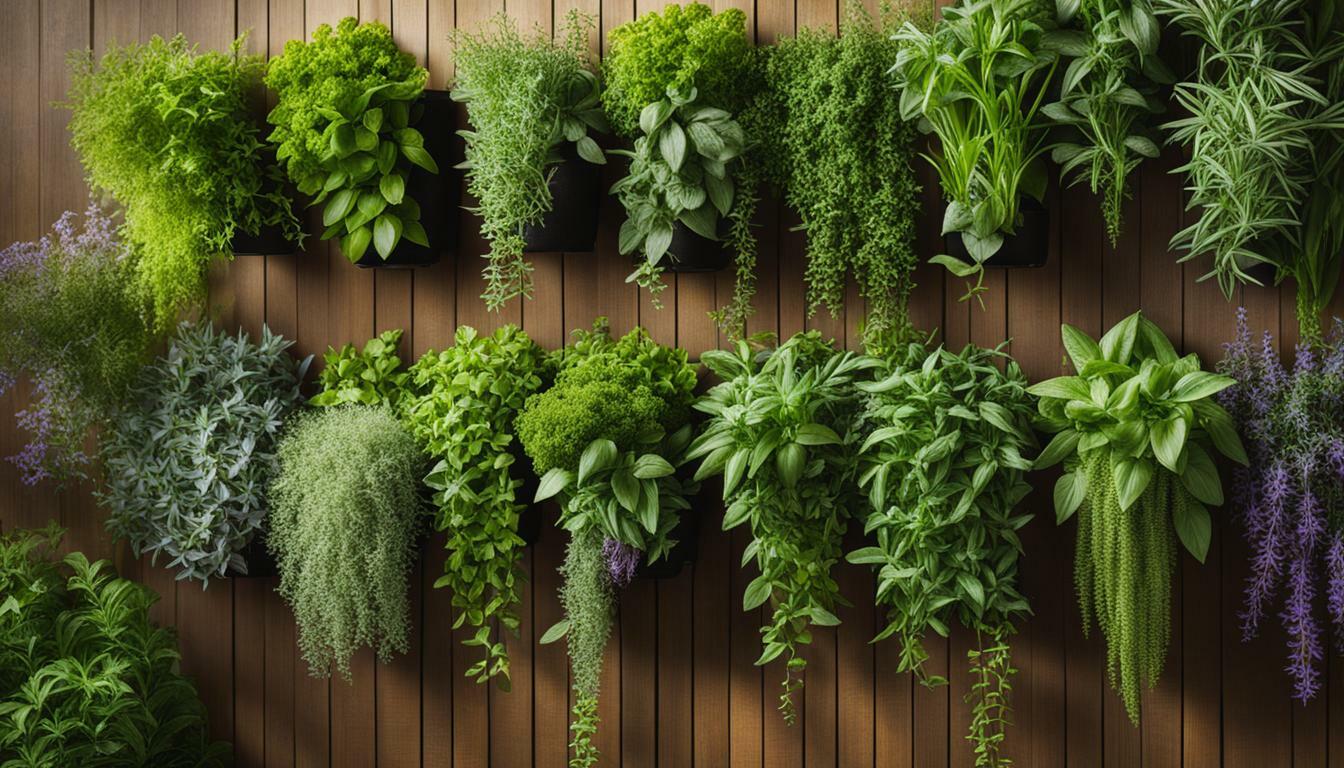Revolutionize your outdoor space with a vertical herb garden and unlock the potential of your small garden or limited outdoor area. Vertical gardening is a clever and innovative way to maximize your space and create a stunning outdoor display. By growing your herbs vertically, you not only save space but also add a unique and eye-catching element to your garden.
Key Takeaways:
- Vertical herb gardens are a space-saving solution for small outdoor areas.
- They provide easy accessibility to your herbs and make it convenient to change plants as needed.
- Vertical gardens can be designed and arranged in various creative ways to enhance your outdoor space.
- Creating your own vertical herb garden can be a rewarding and enjoyable DIY project.
- Choosing the right herbs for your vertical garden ensures a bountiful harvest and adds beauty to your space.
- Maintaining and caring for your vertical herb garden is essential for its long-term health and productivity.
- Vertical gardening can be adapted for indoor spaces, making it suitable for herb gardens in apartments or homes with limited outdoor areas.
- Seek expert advice and inspiration to guide you in creating a stunning vertical outdoor herb garden.
With these key takeaways in mind, let’s explore the benefits, design ideas, DIY tips, herb selection, and maintenance tips for your vertical outdoor herb garden. Whether you have a small balcony or a spacious backyard, a vertical herb garden is a fantastic way to transform your space and enjoy the beauty and convenience of fresh herbs just steps away from your kitchen.
The Benefits of a Vertical Outdoor Herb Garden
Vertical outdoor herb gardens offer numerous benefits for gardeners in small spaces, providing an efficient solution for growing herbs and maximizing your outdoor area. Whether you have a small balcony, a limited backyard, or even just a wall, vertical herb gardens allow you to take advantage of vertical space and transform it into a thriving garden. Here are some key benefits of vertical outdoor herb gardens:
- Space-saving: One of the biggest advantages of vertical herb gardens is their ability to maximize limited space. By growing herbs vertically, you can make use of walls, fences, or even hanging structures to create a lush garden without taking up valuable floor space. This is especially beneficial for those living in urban areas or apartments with limited outdoor areas.
- Accessibility: With a vertical herb garden, you can easily access your plants for harvesting, watering, and maintenance. No more bending over or crouching down to tend to your herbs. They are at eye-level or within reach, making it convenient to care for them and enjoy the fresh flavors they provide in your cooking.
- Improved aesthetics: Vertical herb gardens add a unique visual element to your outdoor space. They can transform a plain wall or fence into a vibrant and lush display of greenery. Not only do they provide fresh herbs for your culinary adventures, but they also enhance the overall aesthetics of your outdoor area, creating a beautiful and inviting atmosphere.
- Better air circulation and sunlight exposure: By growing herbs vertically, you can create better air circulation around the plants, reducing the risk of fungal diseases. Additionally, vertical gardens allow each plant to receive adequate sunlight, ensuring proper growth and photosynthesis for optimal herb production.
- Easy maintenance: Vertical herb gardens are generally easy to maintain. With proper planning and design, you can incorporate efficient watering systems, such as drip irrigation or self-watering containers, to minimize the time and effort required for watering. Vertical gardens also tend to have fewer issues with pests and weeds, making maintenance tasks more manageable.
- Flexibility and versatility: Vertical gardens offer flexibility in terms of plant choices. You can grow a wide variety of herbs, from common culinary herbs like basil, mint, and parsley, to more exotic and specialty herbs. Additionally, vertical gardening allows you to experiment with different designs, arrangements, and combinations of herbs, bringing creativity and personalization to your outdoor space.
With all these benefits, it’s no wonder that vertical outdoor herb gardens have gained popularity among gardeners with limited space. They offer a practical and attractive solution for growing herbs, providing fresh flavors, aesthetic appeal, and a sense of accomplishment in creating a sustainable and beautiful garden.
Vertical Outdoor Herb Garden Inspiration
If you’re looking for inspiration to create your own vertical outdoor herb garden, here are some ideas to get you started:
| Vertical Garden Idea | Image |
|---|---|
| Vertical herb garden fence | 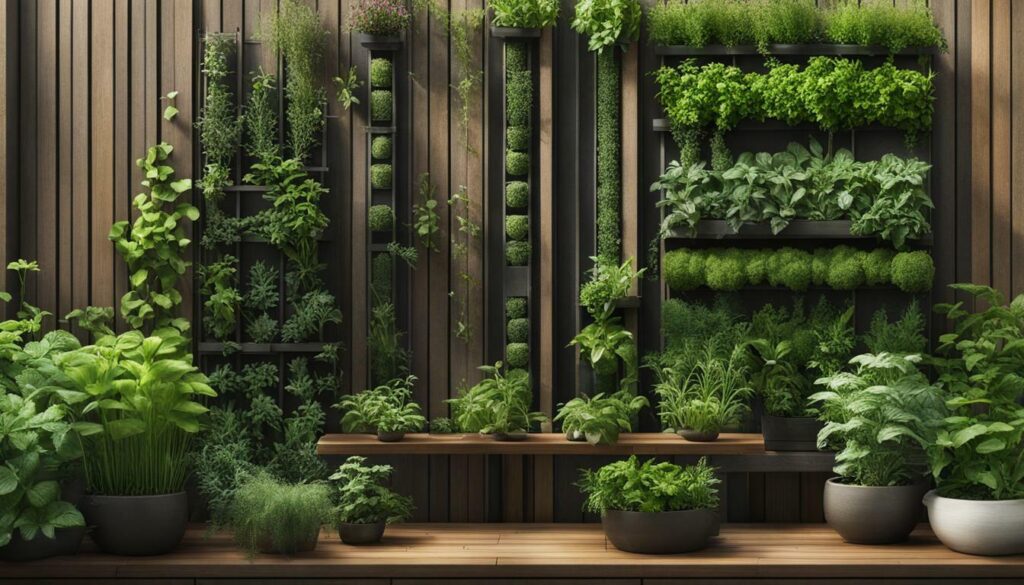 |
| Green walls of container plants | 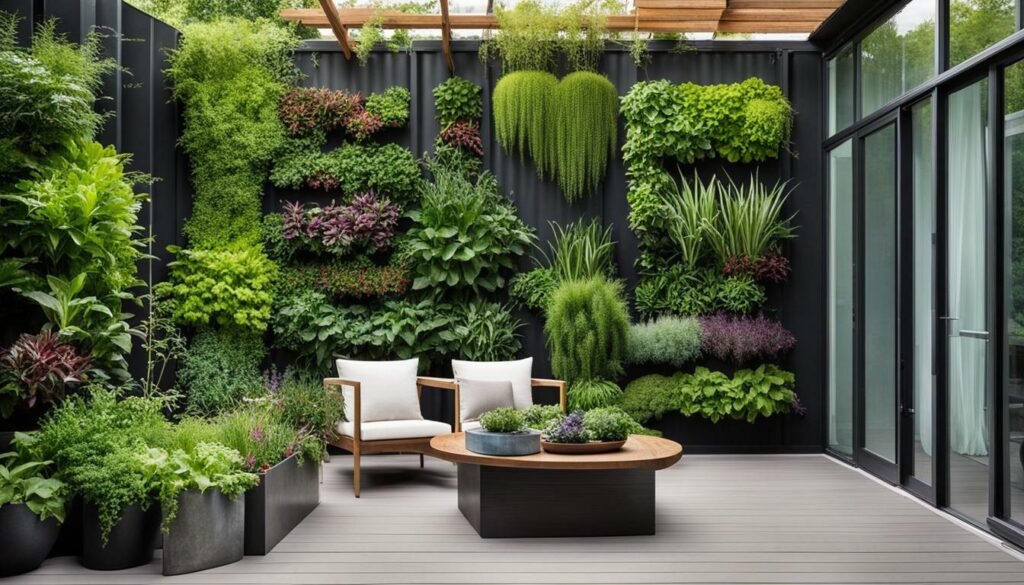 |
| Hydroponic living walls | 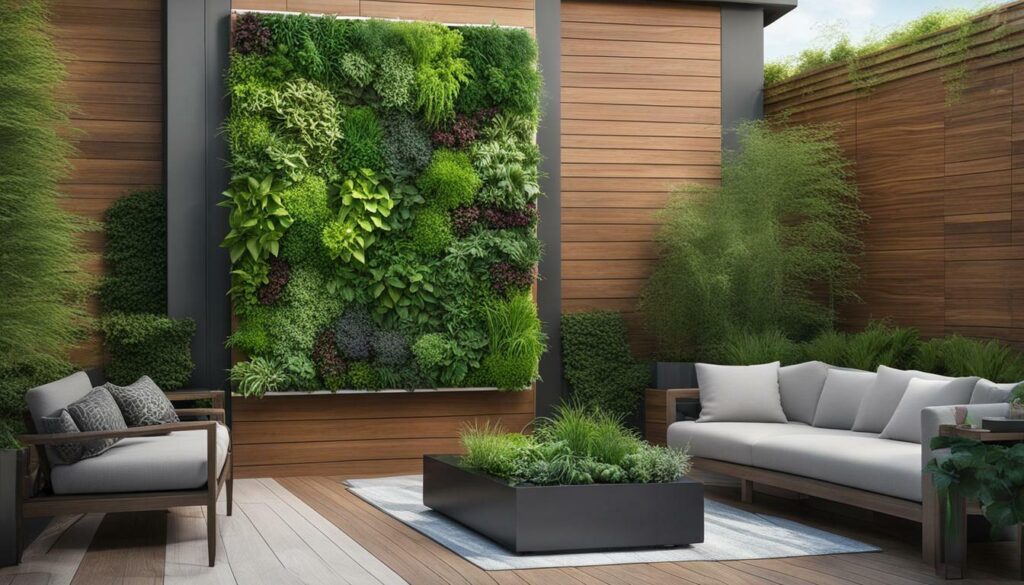 |
| Pallet planters | 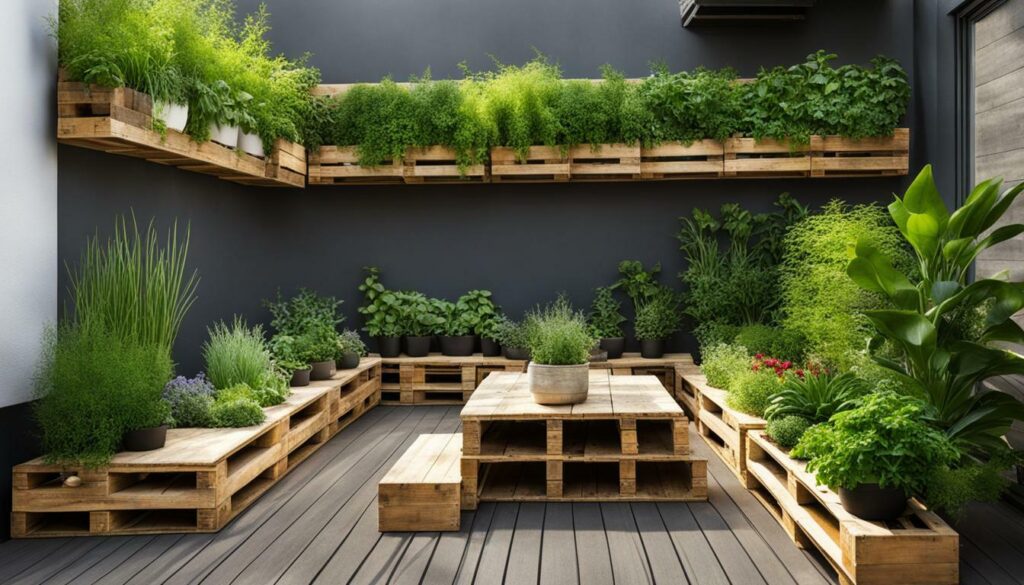 |
| Build a gutter garden | 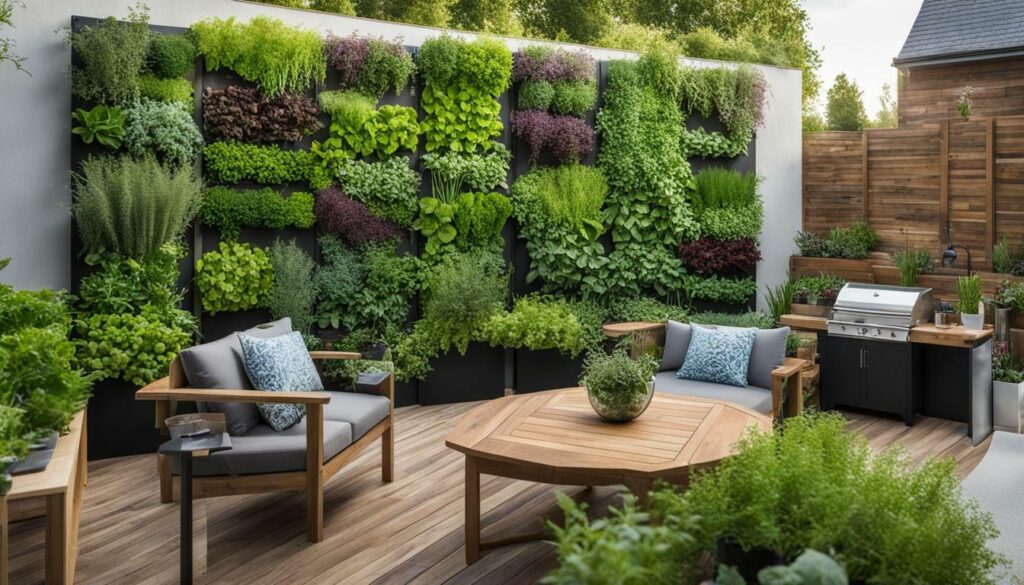 |
These ideas showcase the versatility and creativity of vertical herb gardens, allowing you to find a design that suits your space and personal style. Whether you choose to build your own vertical garden or purchase a ready-made solution, the possibilities are endless when it comes to growing herbs vertically and revolutionizing your outdoor space.
Enhancing Your Outdoor Space with a Vertical Herb Garden Design
Get creative with your outdoor space by incorporating a well-designed vertical herb garden that not only provides fresh herbs but also adds beauty and style to your outdoor area. Vertical gardening allows you to maximize your space and create a stunning display of plants that can transform any dull wall or fence into a vibrant living wall.
There are numerous design ideas and arrangements that you can explore when creating your vertical herb garden. Whether you prefer a sleek and modern look or a more rustic and natural feel, there is a design to suit every taste and style. Consider using different types of containers, such as hanging baskets, wall planters, or repurposed gutters, to add visual interest and variety to your garden.
One popular design idea is to create a vertical herb garden using trellises. These frames can be attached to an exterior wall or left freestanding against another structure. By training climbing plants to grow up the trellis, you can create a beautiful green wall of herbs. Another option is to use container planters to create a living wall. You can affix pots or wall planters to a fence, exterior wall, or freestanding structure, allowing you to easily change and rearrange plants as desired.
If you’re feeling crafty, you can even build your own vertical herb garden using materials such as pallets or plumbing pipes. These DIY projects can be a fun and rewarding way to personalize your garden and showcase your creativity. Remember to choose herbs that are well-suited for vertical gardening, such as cascading herbs like thyme or trailing herbs like oregano.
Table: Vertical Herb Garden Design Ideas
| Design Idea | Description |
|---|---|
| Trellises for Vining Plants | Attach mesh lattice trellises to walls or structures to support climbing plants. |
| Green Walls of Container Plants | Use pots or wall planters to create a living wall of herbs and plants. |
| Hydroponic Living Walls | Grow plants in nutrient-rich water without soil using hydroponic systems. |
| Pallet Planters | Repurpose pallets to create vertical herb gardens with individual planter sections. |
These are just a few examples of the many design ideas available for creating a stunning vertical herb garden. Whether you have a small balcony, a limited garden space, or simply want to add a unique feature to your outdoor area, a vertical herb garden can be the perfect solution. With a bit of creativity and some green thumbs, you can transform your outdoor space into a thriving garden oasis.

DIY Tips for Creating Your Vertical Outdoor Herb Garden
Discover the satisfaction of creating your own vertical outdoor herb garden with these helpful DIY tips and planting techniques. Whether you have limited space or simply want to add a unique touch to your outdoor space, a vertical herb garden is a practical and beautiful solution. Follow these tips to get started on your DIY project.
1. Choose the Right Location
Before you begin building your vertical herb garden, consider the location where it will be placed. Choose a spot that receives adequate sunlight for the herbs you plan to grow. Most herbs require at least 6 hours of direct sunlight per day. Additionally, ensure that the location is easily accessible for watering and maintenance.
2. Select the Right Materials
When building your vertical herb garden, choose sturdy and weather-resistant materials that will withstand outdoor conditions. Common materials include wood, metal, or PVC pipes. Consider using recycled or repurposed materials to make your garden environmentally friendly. Ensure that the materials are securely fastened to create a stable structure.
3. Plan the Layout
Before planting your herbs, plan the layout of your vertical garden. Consider the size and growth habits of your chosen herbs and arrange them accordingly. Place taller herbs at the back or center of the garden, and shorter herbs towards the front. This will ensure that all herbs receive adequate sunlight and allow for easy harvesting.
4. Proper Planting Techniques
When planting your herbs, use well-draining soil or a mix of potting soil and compost. Ensure that each herb has enough space to grow and expand its roots. Water the herbs thoroughly after planting and monitor the moisture levels regularly. Remember to water consistently, but avoid overwatering as this can lead to root rot.
Additionally, consider adding a drip irrigation system to provide a steady water supply to your herbs. This can help conserve water and ensure that your vertical garden remains healthy and vibrant.
| Herb | Light Requirements | Watering Needs |
|---|---|---|
| Basil | Full sun | Regular watering |
| Thyme | Full sun to partial shade | Well-drained soil, allow to dry between waterings |
| Mint | Partial shade to full sun | Regular watering, keep soil consistently moist |
| Parsley | Part shade to full sun | Regular watering, allow soil to dry slightly between waterings |
Remember to regularly trim and harvest your herbs to promote growth and maintain the shape of your vertical garden. Enjoy the bountiful harvest of fresh herbs from your own backyard!
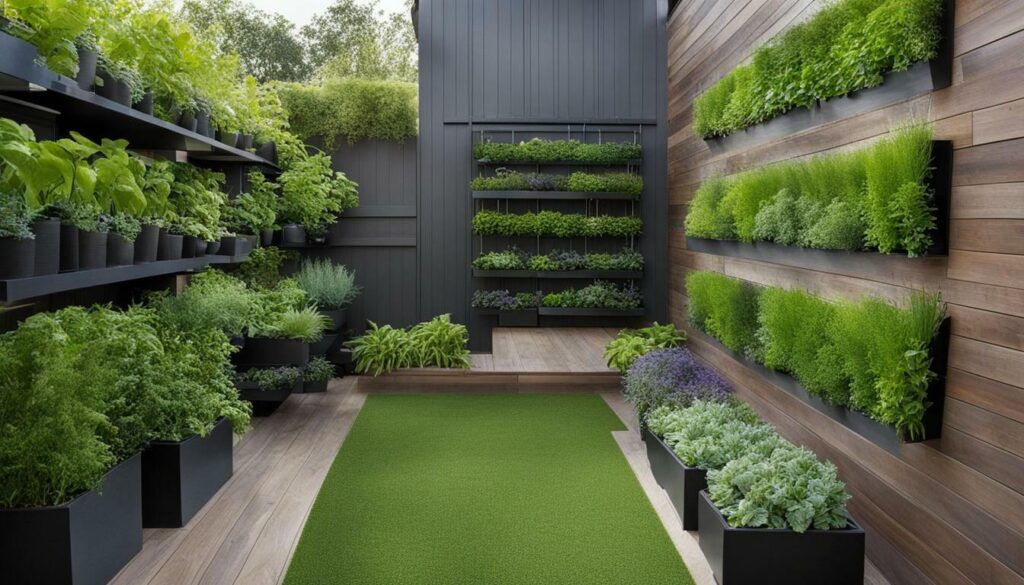
Choosing the Right Herbs for Your Vertical Outdoor Herb Garden
Selecting the right herbs for your vertical outdoor herb garden is crucial for a successful and abundant harvest. Not all herbs thrive in small spaces or are suitable for vertical gardening. It’s important to choose herbs that have compact growth habits, can tolerate being grown in containers, and can adapt well to the unique conditions of a vertical garden.
Here are some of the best herbs to consider for your vertical outdoor herb garden:
| Herb | Description |
|---|---|
Basil  |
Basil is a popular herb that is easy to grow and thrives in containers. It has a compact growth habit and can be harvested frequently for use in cooking. It also repels insects, making it a great companion plant in your garden. |
Thyme  |
Thyme is a hardy herb that can tolerate a variety of growing conditions. It has a low, spreading growth habit and produces small leaves that are packed with flavor. Thyme is a great addition to culinary dishes and also has medicinal properties. |
Parsley 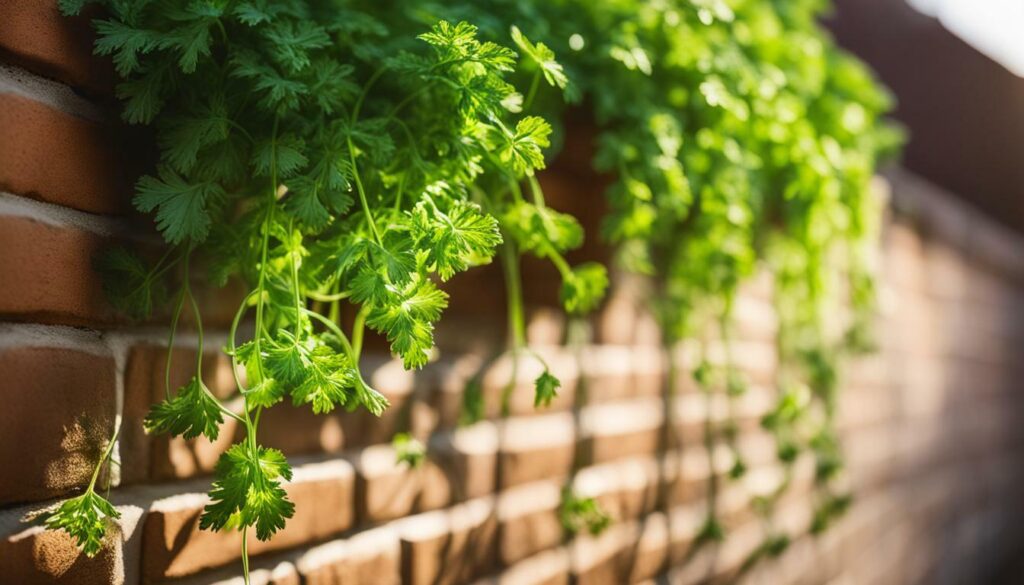 |
Parsley is a biennial herb that is commonly used as a garnish or flavoring in dishes. It has a compact growth habit and can be harvested throughout the growing season. Parsley is rich in vitamins and minerals and adds freshness to any dish. |
Chives 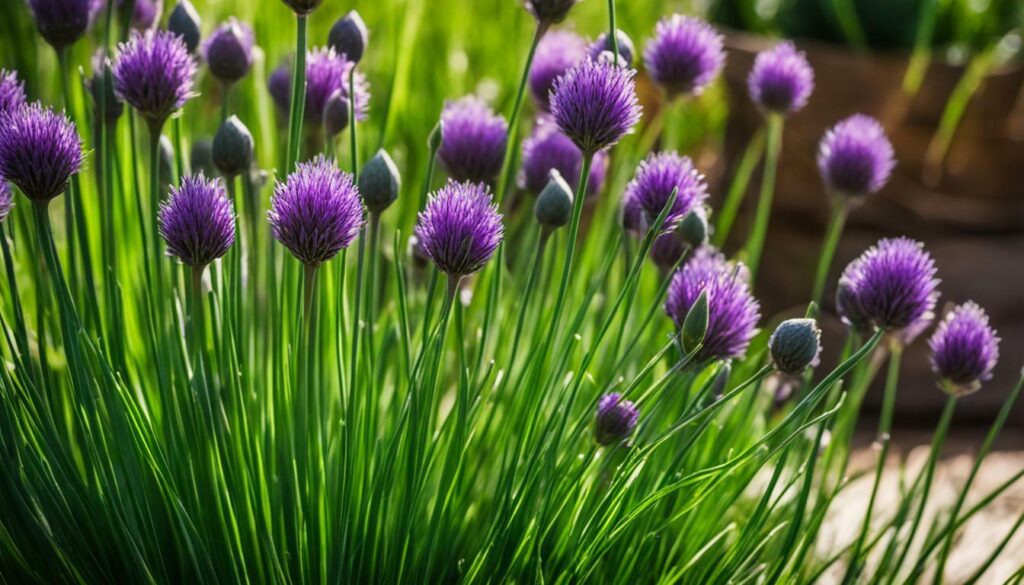 |
Chives are a versatile herb that can be used in a variety of dishes. They have a clumping growth habit and produce slender, hollow leaves that are rich in flavor. Chives also produce beautiful purple flowers, making them a visually appealing addition to your garden. |
These are just a few examples of herbs that are well-suited for vertical gardening. Other herbs to consider include mint, rosemary, cilantro, and oregano. Remember to choose herbs that you enjoy using in your cooking and that will thrive in the specific conditions of your outdoor space.
By selecting the right herbs for your vertical outdoor herb garden, you can create a beautiful and functional garden that will provide you with fresh herbs all season long.
Maintaining and Caring for Your Vertical Outdoor Herb Garden
Ensure the health and vitality of your vertical outdoor herb garden with these essential maintenance and care tips.
1. Watering: Proper watering is crucial for the success of your vertical outdoor herb garden. The vertical arrangement of the garden can result in faster drainage, so it’s important to monitor the moisture levels regularly. Check the soil moisture by sticking your finger about an inch into the soil. If it feels dry, water the plants thoroughly.
2. Pruning: Regular pruning helps maintain the shape and appearance of your vertical herb garden. Trim any dead or yellowing leaves to encourage healthy growth. Pruning also prevents overcrowding and improves air circulation, reducing the risk of diseases.
3. Pest Control: Keep an eye out for common garden pests like aphids, snails, and slugs. These pests can quickly infest your herb garden and damage the plants. Use organic pest control methods such as handpicking, companion planting, or natural sprays to protect your herbs.
4. Fertilizing: Herbs are generally low-maintenance plants, but they still benefit from regular fertilization. Use a balanced, organic fertilizer to provide essential nutrients to your vertical herb garden. Follow the manufacturer’s instructions for application rates and frequency.
5. Sunlight: Ensure that your vertical outdoor herb garden receives adequate sunlight. Most herbs thrive in full sun, so choose a location that gets at least 6-8 hours of direct sunlight daily. If your garden is in a shaded area, consider using supplemental grow lights to provide the necessary light for your plants.
Table: Common Herbs and Their Care Requirements
| Herb | Watering | Light | Temperature |
|---|---|---|---|
| Basil | Regular watering, keep soil evenly moist | Full sun | 60-75°F (15-24°C) |
| Rosemary | Allow soil to dry between waterings | Full sun | 60-90°F (15-32°C) |
| Mint | Keep soil consistently moist | Partial shade to full sun | 65-75°F (18-24°C) |
| Parsley | Evenly moist soil, avoid overwatering | Partial shade to full sun | 70-85°F (21-29°C) |
By following these maintenance and care tips, your vertical outdoor herb garden will thrive and provide a bountiful harvest of fresh herbs for all your culinary needs.
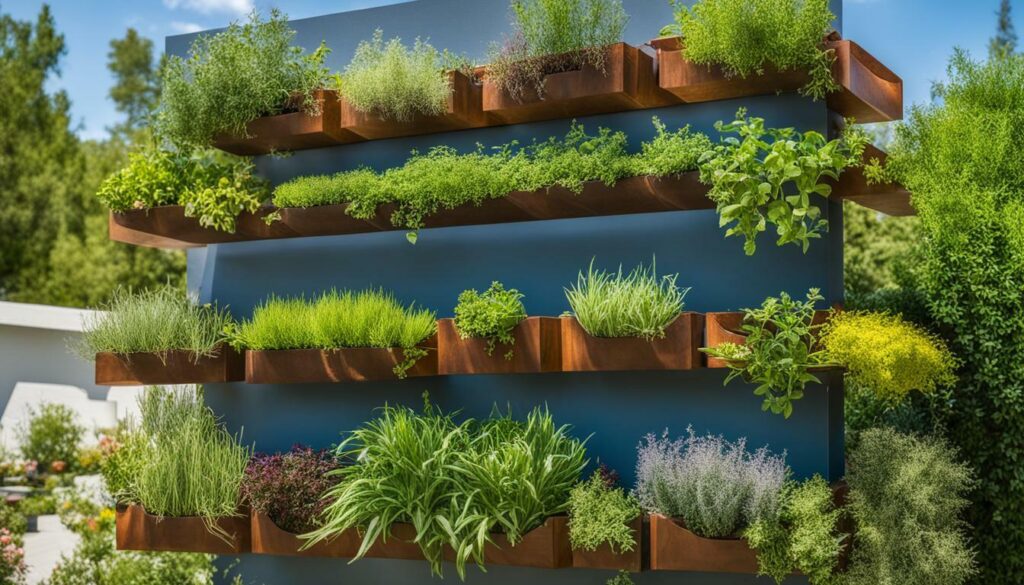
Additional Ideas for Using Vertical Gardening in Your Outdoor Space
Vertical gardening offers endless possibilities for maximizing your outdoor space. Discover additional ideas for utilizing this innovative gardening technique in your own backyard.
1. Trellises for Vining Plants
Growing vining plants on trellises is a great way to add vertical interest to your outdoor space. Install mesh lattice trellises against an exterior wall or freestanding structure and train plants to climb up. This method is ideal for growing fruit, flowers, herbs, and vegetables, and it saves space while enabling better air circulation and pest control.
2. Green Walls of Container Plants
Create living walls by attaching pots or wall planters to fences, exterior walls, or freestanding structures. This method allows you to easily grow a variety of plants, whether it’s flowers, herbs, vegetables, or a mix of them. Container planters provide flexibility in terms of changing plants and pot arrangement, and they add beauty to your outdoor space.
3. Hydroponic Living Walls
Take vertical gardening to the next level with hydroponics. Instead of using soil, hydroponic systems grow plants in nutrient-rich water. These systems can be installed on walls, pipes, towers, or gutters, and they offer advantages such as reduced water usage, improved plant growth, and enhanced aesthetics. Hydroponic living walls are perfect for growing a wide range of plants, including fruits, flowers, herbs, and vegetables.
4. Pallet Planters
Repurpose wooden pallets as vertical planters. Attach pots or containers to the pallet boards and fill them with soil to create a unique vertical garden. Pallet planters are versatile and can be hung on walls, fences, or freestanding structures, allowing you to maximize your outdoor space. This DIY approach is cost-effective and provides a rustic and charming look to your garden.
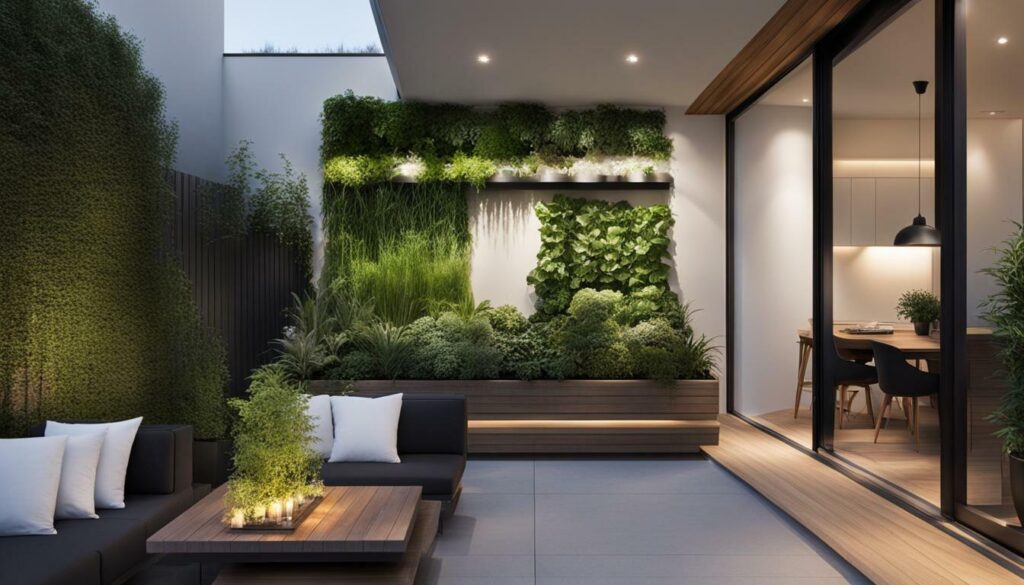
Explore these additional ideas for using vertical gardening in your outdoor space and create a stunning and practical garden that maximizes your available area.
| Idea | Benefits |
|---|---|
| Trellises for Vining Plants | – Saves space – Better air circulation – Pest control |
| Green Walls of Container Plants | – Flexibility in plant arrangement – Adds beauty to outdoor space |
| Hydroponic Living Walls | – Reduced water usage – Improved plant growth – Enhanced aesthetics |
| Pallet Planters | – Cost-effective – Rustic and charming look |
With these ideas, you can transform your outdoor space into a thriving vertical garden that not only looks beautiful but also maximizes the use of your available area.
Vertical Gardening Solutions for Indoor Spaces
Vertical gardening is not limited to outdoor spaces. Explore how you can bring the benefits of vertical gardening indoors with an indoor herb garden. Whether you have a small apartment or limited outdoor access, creating a vertical herb garden indoors allows you to enjoy fresh herbs all year round.
One popular option for indoor vertical gardening is to use wall-mounted planters or hanging pots. These can be attached to walls or hung from ceilings, making use of vertical space and creating a beautiful display of herbs. For a sleek and modern look, consider using vertical hydroponic systems that use nutrient-rich water instead of soil, allowing plants to grow vertically without the need for traditional pots or planters.
Another creative solution for indoor vertical gardening is to repurpose everyday items such as gutters or pallets. By mounting gutters horizontally on a wall, you can create a unique herb garden with individual compartments for each herb. Pallets can also be transformed into vertical planters by adding shelves or planting pockets for herbs to grow.
| Vertical Gardening Solutions for Indoor Spaces |
|---|
| Wall-mounted planters or hanging pots |
| Vertical hydroponic systems |
| Repurposed gutters or pallets |
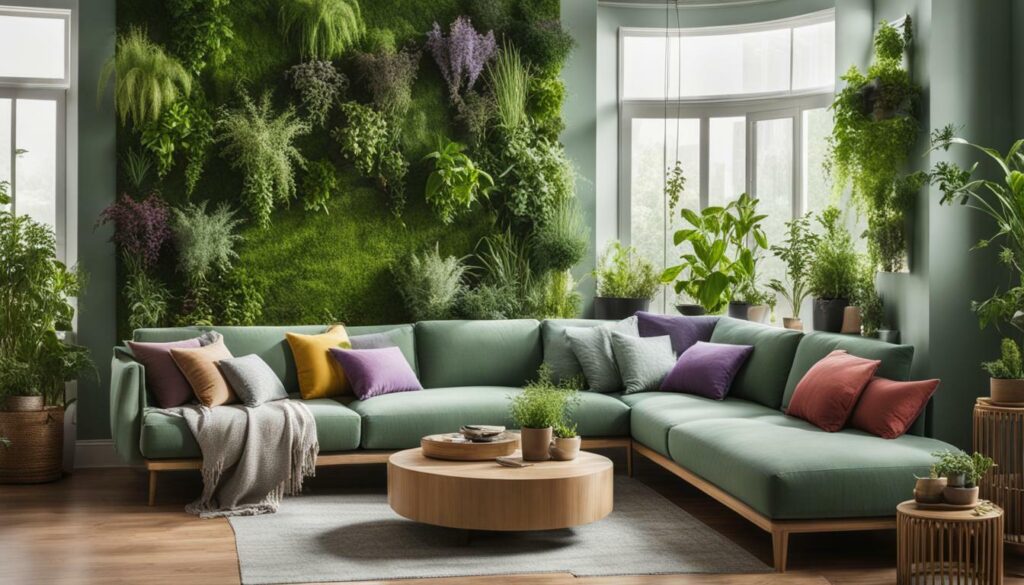
When choosing herbs for your indoor vertical garden, opt for varieties that thrive in indoor conditions and require less space to grow. Popular choices include basil, parsley, mint, and thyme. These herbs not only add flavor to your dishes but also emit pleasant aromas, enhancing the ambiance of your indoor space.
Maintaining an indoor vertical herb garden is relatively easy. Make sure to provide adequate light, either through natural sunlight or by using grow lights. Water the herbs regularly and ensure proper drainage to prevent overwatering. Pruning and harvesting regularly will promote healthy growth and keep the herbs flourishing.
Key Takeaways:
- Indoor vertical gardening allows you to bring the benefits of vertical gardening indoors.
- Wall-mounted planters, vertical hydroponic systems, and repurposed gutters or pallets are popular solutions for indoor vertical gardens.
- Choose herbs that thrive in indoor conditions and provide aroma and flavor, such as basil, parsley, mint, and thyme.
- Maintain your indoor vertical herb garden by providing adequate light, regular watering, and proper pruning and harvesting.
Expert Advice and Inspiration for Your Vertical Outdoor Herb Garden
Get inspired and learn from the experts with these valuable tips and advice for designing and cultivating your own vertical outdoor herb garden.
One of the best things about vertical gardening is the versatility and creativity it offers. There are endless possibilities for designing and arranging your vertical herb garden to suit your space and personal style. Whether you have a small balcony, a backyard patio, or even just a blank wall, you can transform it into a thriving herb garden with vertical solutions.
To help you get started, here are some expert tips and ideas:
1. Utilize Vertical Space
The key to successful vertical gardening is maximizing the use of vertical space. Take advantage of walls, fences, trellises, and other vertical structures to create layers of planters or hanging baskets. This not only saves space but also allows you to grow a wide variety of herbs in a small area.
2. Choose the Right Herbs
- Consider the herbs you use most frequently in your cooking and prioritize those for your herb garden. Popular options include basil, parsley, mint, rosemary, thyme, and cilantro.
- Take into account the sunlight requirements of different herbs and group them accordingly to ensure they receive the appropriate amount of light.
- Remember that some herbs, like mint, can be invasive and may need to be planted in separate containers to prevent them from taking over the garden.
3. Provide Proper Care and Maintenance
Like any garden, vertical herb gardens require regular care and maintenance to thrive. Here are some important tips:
- Water your herbs regularly, ensuring that the soil is moist but not overly saturated.
- Trim and prune your herbs as needed to encourage healthy growth and prevent overcrowding.
- Monitor for pests and diseases, and take appropriate measures to control them. Organic pest control methods, such as neem oil or insecticidal soap, are recommended for herb gardens.
By following these expert tips and incorporating your own creativity, you can create a stunning vertical outdoor herb garden that not only enhances your outdoor space but also provides you with fresh and flavorful herbs for your culinary creations.
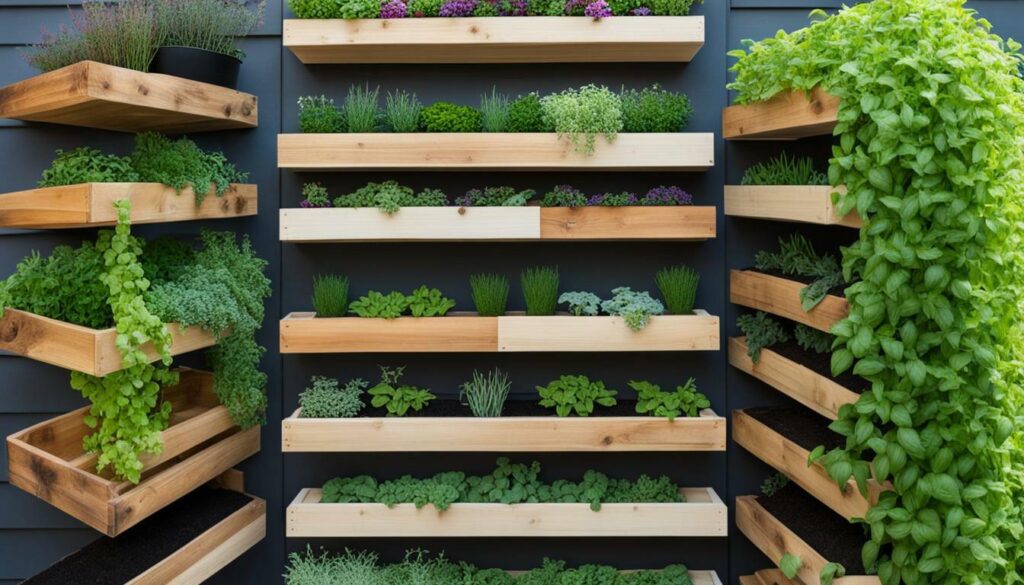
| Expert Tip | Quote |
|---|---|
| “Vertical gardening allows you to grow more plants in a smaller space, making it ideal for urban gardening and small outdoor areas.” | —Garden Design Expert |
| “Group herbs with similar watering and sunlight needs together to ensure their optimal growth and health.” | —Herb Gardening Specialist |
| “Regular pruning and harvesting of your herbs not only keeps them healthy but also promotes bushier and more productive growth.” | —Professional Horticulturist |
With a little creativity, care, and expert advice, you can create a vertical outdoor herb garden that not only adds beauty to your space but also provides you with an abundant supply of fresh herbs for your culinary endeavors. So, get started and revolutionize your outdoor space with a vertical herb garden today!
Conclusion
Transform your outdoor space and elevate your gardening experience with a vertical outdoor herb garden. Embrace the beauty, functionality, and convenience of this innovative gardening technique. With the benefits of saving space and easy accessibility, a vertical herb garden is the perfect solution for small-space gardening.
Enhance your outdoor space with a carefully designed vertical herb garden. Explore different design ideas and arrangements to create a visually stunning and practical garden that fits your needs. Whether it’s a vertical herb garden fence, repurposed gutters, or a bamboo planter, there are plenty of options to choose from.
Create your own vertical outdoor herb garden with DIY tips and tricks. From selecting the right herbs to providing step-by-step instructions, you can bring your gardening dreams to life. Take pride in creating a unique and personalized space that suits your taste and style.
Choose the right herbs for your vertical outdoor herb garden to ensure a successful and bountiful harvest. Consider factors such as sunlight, temperature, and space requirements to select the herbs that thrive in your garden. From aromatic basil to versatile parsley, the options are endless.
Maintaining and caring for your vertical outdoor herb garden is essential for its longevity and productivity. Follow proper watering techniques, pruning practices, and pest control methods to keep your garden healthy and thriving. With a little care and attention, your vertical herb garden will provide you with fresh herbs all season long.
Looking beyond herb gardens, explore other creative ways to incorporate vertical gardening into your outdoor space. From flowers to vegetables, vertical gardening offers endless possibilities for maximizing your gardening potential in small spaces.
If you’re limited to indoor spaces, don’t worry! Vertical gardening can be adapted for indoor environments, particularly for herb gardens. Discover how to create a vertical indoor herb garden to bring the beauty and freshness of herbs into your home.
Seek expert advice and inspiration to take your vertical outdoor herb garden to the next level. Learn from professionals about design ideas, maintenance tips, and creative uses for vertical gardening. With their expertise, you can create a stunning and functional vertical outdoor herb garden that will be the envy of your neighbors.
In conclusion, revolutionize your outdoor space with a vertical outdoor herb garden. Embrace the benefits of space-saving, accessibility, and the beauty of vertical gardening. With the right design, maintenance, and selection of herbs, you can create a thriving and visually appealing garden that will transform your outdoor space into a true oasis.
Can a Vertical Herb Garden Be Used for Indoor Spaces as Well?
Yes, a vertical herb garden can definitely be used for indoor spaces as well. With the right lighting and proper care, a vertical herb garden that is typically seen outdoors can be an attractive and functional addition to indoor living spaces.
FAQ
Q: What are the benefits of a vertical outdoor herb garden?
A: Vertical outdoor herb gardens offer space-saving solutions for small outdoor spaces and provide easy accessibility to herbs for cooking and gardening.
Q: How do I design a vertical herb garden for my outdoor space?
A: There are many design ideas for vertical herb gardens, including using trellises, container planters, hydroponic systems, and pallet planters. Choose a design that suits your space and personal style.
Q: Can I create my own vertical outdoor herb garden?
A: Yes, you can create your own vertical outdoor herb garden using DIY tips and techniques. Consider the materials and plants you want to use, and follow step-by-step instructions to build your garden structure.
Q: What herbs are suitable for vertical outdoor herb gardens?
A: Herbs like basil, rosemary, mint, thyme, and parsley are well-suited for vertical outdoor herb gardens. Choose herbs that are suitable for your local climate and culinary preferences.
Q: How do I maintain and care for a vertical outdoor herb garden?
A: Proper maintenance of a vertical outdoor herb garden includes regular watering, pruning, fertilizing, and pest control. Pay attention to the specific needs of each herb and provide necessary care accordingly.
Q: Can vertical gardening be adapted for indoor spaces?
A: Yes, vertical gardening can be adapted for indoor spaces, including indoor herb gardens. Choose the right plants, provide adequate lighting, and ensure proper drainage for successful indoor vertical gardening.
Q: Where can I find expert advice and inspiration for my vertical outdoor herb garden?
A: Look for professional landscaping and gardening resources, websites, and blogs that offer expert advice, tips, and inspiration for vertical outdoor herb gardens. You can also seek guidance from local horticultural experts.
Q: What are some additional ideas for using vertical gardening in outdoor spaces?
A: Besides vertical herb gardens, you can use vertical gardening techniques for growing flowers, vegetables, and even decorative plants in outdoor spaces. Explore creative ideas like trellises, living walls, and tower gardens.

